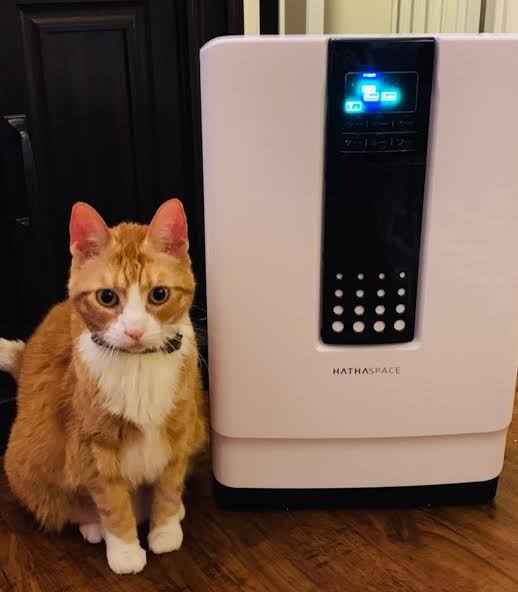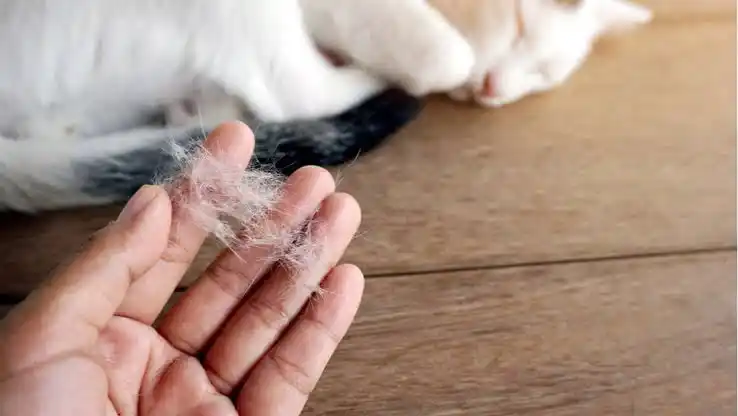Do Air Purifiers Help With Cat Hair and Pet Allergies?

Are you constantly battling cat hair in your home? Does it feel like no matter how much you clean, hair and allergens still linger in the air? Owning a cat can be incredibly rewarding, but let’s face it—managing the hair and allergens they leave behind is a constant challenge.
Floating cat hair not only affects the cleanliness of your home but can also compromise indoor air quality. If you’ve ever wondered whether air purifiers can help tackle this issue, the answer isn’t just yes—it’s how you use them.
This guide explores everything you need to know about using air purifiers to manage cat hair, reduce allergens, and improve the air you breathe.
Why Is Cat Hair in the Air a Problem?

The Reality of Cat Hair and Dander
Cat hair can quickly accumulate on furniture, clothing, and even in the air. While the hair itself is easy to spot and clean, the real problem lies in the accompanying dander—microscopic flakes of skin shed by your cat. These tiny particles are so light that they easily become airborne, circulating throughout your home. Once in the air, they settle on surfaces, enter HVAC systems, and linger for days, creating a persistent issue for pet owners.
The result is not just a hairy home but also compromised indoor air quality. For individuals with allergies or respiratory conditions, exposure to airborne dander can lead to symptoms like sneezing, congestion, and asthma flare-ups. Even if you don’t have allergies, prolonged exposure to poor air quality isn’t ideal for anyone.
Why does this matter? Airborne cat hair and dander not only create a messy environment but also contribute to poor indoor air quality, which can negatively impact your health over time.
The Hidden Impact of Pet Hair on Allergies
Cat hair often carries more than just dander—it can trap saliva proteins, dust mites, and outdoor allergens your pet picks up while roaming. These allergens can exacerbate existing respiratory issues or create new sensitivities.
For individuals with pet allergies, even minimal exposure to cat hair and dander can trigger sneezing, watery eyes, and respiratory discomfort. Dander contains proteins (like Fel d 1) that are highly allergenic, and because it’s so light, it can remain suspended in the air for long periods. Even if you don’t have allergies, inhaling these particles daily may lead to irritation or long-term breathing issues.
If you notice itchy eyes, constant sneezing, or difficulty breathing, the pet hair and its accompanying allergens may be the culprits. Managing these particles in your home becomes essential not just for cleanliness but for health.
How Do Air Purifiers Work for Pet Owners?

The Role of HEPA Air Purifiers
HEPA (High-Efficiency Particulate Air) filters are a must-have feature in air purifiers for homes with pets. These advanced filters are engineered to trap 99.97% of particles as small as 0.3 microns, making them effective against common pet-related pollutants like dander, pollen, and dust. While HEPA filters excel at capturing these fine particles, they can also help reduce the presence of floating hair, though not as effectively as larger cleaning tools like vacuums.
HEPA air purifiers continuously cycle air, drawing in polluted air, filtering out impurities, and releasing clean air. Over time, this process helps significantly reduce airborne irritants, creating a healthier environment for you and your cat.
Moreover, some air purifiers come with additional filters, like activated carbon filters, which help neutralize odors caused by pets. This is especially beneficial for cat owners dealing with litter box smells.
Can Air Purifiers Remove Cat Hair?
Although air purifiers are primarily designed to capture microscopic particles, they can also help with visible cat hair to some extent. Purifiers equipped with pre-filters act as the first line of defense, trapping larger particles like hair before they reach the HEPA filter. However, air purifiers are not a substitute for regular cleaning.
Think of air purifiers as part of a complementary tools that enhance overall air quality rather than devices that eliminate all pet hair.
Best Air Purifiers for Cat Hair and Allergies

Top Features to Look for in an Air Purifier
When selecting an air purifier for a pet-friendly home, pet owners should prioritize these features:
- HEPA Filters: Ensure the purifier is equipped with a True HEPA filter for maximum efficiency in trapping allergens and dander.
- Pre-Filters: These help catch larger particles, like pet hair, extending the life of the main filter.
- Activated Carbon Filters: These help neutralize odors caused by pets, such as litter box smells, ensuring your home smells fresh.
- Coverage Area: Choose a purifier that matches the size of the room where your cat spends most of its time.
- Quiet Operation: Essential if you want to run the purifier without disturbing your household or your cat.
- CADR (Clean Air Delivery Rate): Indicates how quickly the purifier can clean the air in a given space. A higher CADR is ideal for homes with pets.
Recommended Air Purifiers for Cat Hair
- Levoit Core P350: Designed with pet owners in mind, this purifier combines a True HEPA filter with an activated carbon layer to remove odors and allergens.
- Blueair Blue Pure 211+: Known for its high CADR and washable pre-filters for trapping hair, making it effective and easy to maintain.
- Dyson Purifier Cool: A two-in-one device that purifies air while doubling as a fan, ideal for pet owners in warmer climates.
Budget-Friendly vs. Premium Options
For those on a budget, the Levoit Core Mini offers excellent filtration for small spaces. If you have a larger budget, the Rabbit Air MinusA2 provides customizable filters and whisper-quiet operation, making it perfect for large homes with multiple pets.
Do Air Purifiers Help With Pet Allergies?

The Science Behind Air Purification for Allergens
Pet dander and allergens are some of the most common indoor pollutants, and air purifiers equipped with HEPA filters are highly effective at reducing their presence. By continuously drawing in air, filtering out allergens, and recirculating clean air, purifiers can significantly reduce allergy triggers over time, especially when combined with other allergen-reduction practices.
Addressing Common Misconceptions
Some people believe that air purifiers alone can solve all pet hair and allergy problems, but this isn’t entirely accurate. While air purifiers are excellent for reducing airborne particles, they’re most effective when used alongside regular cleaning, grooming, and proper ventilation. Placement is also key— positioning the purifier in high-traffic areas or near your cat’s favorite spots—bed or litter boxensures maximum efficiency.
Alternative Solutions to Reduce Cat Hair in the Air
Daily Cleaning Tips for Pet Hair Control
- Vacuum Regularly: Use a vacuum with a HEPA filter and pet-specific attachments to remove hair and dander from carpets, furniture, and hard floors.
- Lint Rollers and Brushes: Keep these tools handy for quick clean-ups of stray hair from clothes and upholstery.
- Dust Regularly: Use microfiber cloths that attract and trap hair rather than spreading it around.
- Wash Fabrics Often: Bedding, curtains, and cushions can trap hair and dander, so frequent washing is essential.
Air Filters and Ventilation Systems
Consider upgrading your home’s HVAC system with filters designed to trap pet hair and allergens. Installing high-efficiency HVAC filters designed for pet households can help capture airborne hair and allergens as your system circulates air. Combining these with an air purifier creates a double barrier against pollutants by tackling airborne particles on a larger scale.
Grooming Your Cat to Minimize Shedding
Reducing shedding at the source is one of the most effective ways to control cat hair. Invest in grooming tools like de-shedding tools—brushes or gloves to capture loose fur weekly before it becomes airborne. Regular bath sessions with pet-safe shampoos not only reduce shedding but also strengthen your bond with your cat.
Combining Air Purifiers With Other Pet Hair Removal Strategies

How to Maximize the Effectiveness of Air Purifiers
To get the best results:
- Positioning Matters: Place the purifier in high-traffic areas or rooms where your cat spends the most time.
- Replace Filters Regularly: A clogged filter can’t effectively clean the air. Replace them as recommended by the manufacturer to avoid reduced performance.
- Run It Consistently: For the best results, keep your air purifier running throughout the day to maintain consistent air quality.
The Importance of a Multi-Faceted Approach
Air purifiers are most effective when used in combination with daily cleaning, grooming, and proper ventilation. By addressing the issue from multiple angles, you can significantly reduce airborne cat hair and allergens, creating a healthier living space for both you and your pet.
FAQs About Air Purifiers and Cat Hair
Q: Do air purifiers really remove cat hair?
Yes, air purifiers can reduce floating cat hair but are more effective at removing smaller particles like dander and allergens.
Q: Are HEPA filters necessary for pet owners?
Absolutely. HEPA filters are the most effective option for capturing allergens, making them essential for pet-friendly homes.
Q: How often should I change filters in a pet household?
Every 3-6 months, depending on the number of pets and the purifier’s usage. Check the filter regularly for signs of clogging.
Conclusion
Air purifiers are a powerful addition to any pet owner’s home, helping to reduce airborne cat hair, dander, and allergens. While they can’t replace regular cleaning, their ability to improve indoor air quality makes them indispensable for households with cats.
Ready to experience a cleaner, fresher home? Explore our recommended air purifiers for pets hairs and start breathing easier today.
